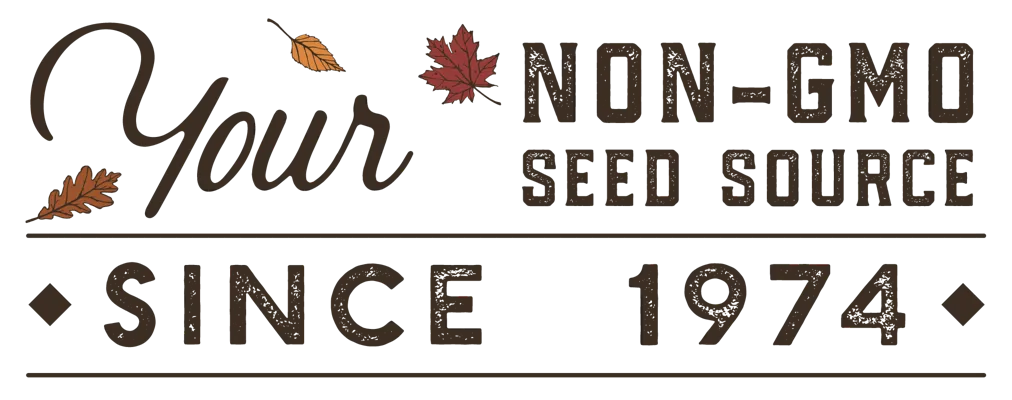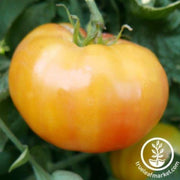Out Of Stock!
We will notify you when this product becomes available.
Tomato Seeds - Slicing - Hillbilly Potato Leaf
80-85 Days to maturity (from transplant). Solanum lycopersicum. Hillbilly Potato Leaf Tomato Seeds. Non-GMO, warm season annual, open-pollinated, heirloom, potato leaf, indeterminate, slicing tomato. Suitable for growing in garden plots, raised beds, and greenhouses. This gorgeous slicing tomato contains incredibly juicy flesh. If its flavor isn't enough to get your taste buds excited, its appearance will! Approximately 6,800 seeds/ounce.




Download Free Vegetable Growing Guide PDF
Growing Hillbilly Potato Leaf Tomatoes in the Vegetable Garden
To plant Hillbilly Potato Leaf Tomatoes, start indoors 7-9 weeks before the last spring frost date in your region. Sow the seeds at a depth of 0.25 inches in well-draining, loose, slightly acidic soil with a pH range of 6.2 to 6.8. Given their indeterminate growth habit, provide support such as a cage or trellis to accommodate their sprawling vines. These tomatoes exhibit a striking yellow and orange color, with a sweet and juicy flavor. Transplant the seedlings outdoors after the danger of frost has passed, spacing them 24-36 inches apart, with rows spaced 36 inches apart. The tomatoes will mature in 80-85 days from transplant, making them late-season producers. While challenging to yield by the 4th of July, they offer a rewarding late-summer to early-fall harvest for most USDA zones. Emphasize well-drained, sandy loam soil, maintain a warmer temperature range of 70-85 F, and expose them to full sun. Suitable for various garden sizes, Hillbilly Potato Leaf Tomatoes are perfect for salads and fresh eating, with their large, round fruits reaching sizes of 4 to 6 inches.
Maintaining the vitality of Hillbilly Potato Leaf Tomatoes involves several key practices and growing tips throughout the growing process. Given their indeterminate growth habit, provide sturdy support with cages or trellises to manage their sprawling vines. Regular pruning, especially of lower leaves, encourages air circulation, reduces disease risk, and directs energy toward fruit production. Mulching around the base of the plants helps retain moisture and suppress weeds. Companion planting with basil can deter common pests while enhancing flavor. Consistent watering is crucial, avoiding both drought stress and waterlogged soil. Fertilize sparingly, prioritizing phosphorus and potassium to encourage fruiting. Check for pests like tomato hornworms and diseases such as late blight regularly, using organic neem-based products for prevention and treatment. Rotate crops annually to minimize soil-borne diseases. Harvest ripe tomatoes regularly to encourage continuous production. These maintenance practices and tips will contribute to a thriving and productive Hillbilly Potato Leaf Tomato garden, ensuring a bountiful supply of sweet and juicy fruits for salads and fresh eating.
Harvesting Hillbilly Potato Leaf Tomatoes
Harvesting Hillbilly Potato Leaf Tomatoes is a delightful process marked by their vibrant colors and sweet, juicy flavor. As an indeterminate variety, these tomatoes continue to produce fruit throughout the growing season, allowing for a staggered harvest. The 80-85 days from transplant maturity period serves as a general guideline, but optimal ripeness is best determined by the tomatoes' bright yellow and sunset red streaked flesh, and their juicy, sweet taste. Individual tomatoes are typically 4 to 6 inches around. Since indeterminate tomatoes provide a prolonged harvest window, it's crucial to pick the fruits as they reach full color and size. Gently twist each tomato off the vine, or use pruning shears to avoid damaging the plant. Regular harvesting encourages the plant to continue producing. This indeterminate nature allows for an extended harvesting period, providing a continuous supply of these gorgeous and flavorful tomatoes for salads, fresh eating, and culinary creations throughout the growing season.
About Hillbilly Potato Leaf Tomato Garden Seeds
Hillbilly Potato Leaf Tomatoes have a history rooted in heirloom cultivation, known for their unique characteristics and historical significance. The specific origins or breeder of this variety may be challenging to trace due to the nature of heirlooms, which often date back generations and are passed down through seed saving and sharing within communities. These tomatoes are a testament to the rich diversity and flavors preserved over time in traditional gardening practices.
Bred for their unique combination of characteristics, Hillbilly Potato Leaf Tomatoes showcase a vibrant yellow and orange color, coupled with a sweet and juicy flavor. While not specifically tailored for a particular growing climate, heirloom varieties like these often exhibit adaptability to various conditions, making them suitable for a wide range of climates and regions.
Beyond their striking appearance and delectable taste, Hillbilly Potato Leaf Tomatoes are noted for their generous size, with individual fruits reaching 4 to 6 inches in diameter. The potato leaf foliage adds a distinctive visual element to the plant, contributing to its overall appeal. This indeterminate variety offers a late-season harvest, producing abundant yields of these large, round tomatoes suitable for salads and fresh eating.
While Hillbilly Potato Leaf Tomatoes can be grown in larger containers, they may pose challenges in small or hanging baskets due to their sprawling growth habit. Containers should provide ample space for their vigorous vines, and support structures like stakes or cages are recommended to manage their indeterminate growth.
Tips From Our Gardeners
"A unique tip for cultivating Hillbilly Potato Leaf Tomatoes is to experiment with pruning techniques. While indeterminate tomatoes benefit from regular pruning of lower leaves for improved air circulation and disease prevention, selectively removing some branches can redirect energy toward larger fruit production, enhancing both size and flavor. Adjust pruning practices based on your specific growing conditions and desired harvest outcomes for these visually stunning and delicious tomatoes."
 |
- Chelsea Hafer, True Leaf Market Writer |
Other Resources
Hillbilly Potato Leaf Tomato Seeds Per Package:
- 300 mg packet - Approximately 65 Seeds
- 0.25 oz - Approximately 1,700 Seeds
- 1 oz - Wholesale - Approximately 6,800 Seeds
- 4 oz - Wholesale - Approximately 27,200 Seeds
- 1 lb - Bulk Seeds - Approximately 108,800 Seeds
Non-GMO Hillbilly Potato Leaf Tomato seeds are available for Fast Free Shipping on qualifying orders.
Basic Info
| Latin Name: | Solanum lycoperscium (previously Lycopersicon esculentum) |
| Tomato Type: | Slicing - Larger, round tomatoes, the size of your fist or larger. |
| Hillbilly Potato Leaf Tomato Color: | Yellow, Orange |
| Hillbilly Potato Leaf Tomato Flavor: | Sweet, juicy |
Growing Info
| Hardiness Zone: | 2, 3, 4, 5, 6, 7, 8, 9, 10, 11 Annual: Not intended to overwinter |
| Days to Maturity: | 80-85 (from transplant) |
| Days to Germination: | 7-10 |
| Seeding Depth: | 0.25 inch |
| Plant Spacing: | 24-36 inches |
| Row Spacing: | 36 inches |
| Plant Height: | 60-72 inches |
| Growth Habit: | Indeterminate - Indeterminate tomatoes are vine-type plants that sprawl (requiring a cage or trellis to support them) and continue to grow throughout the season. Indeterminate tomato plants will continue to produce tomatoes for the rest of the season, so you can harvest continually. |
| Soil Preference: | Well-draining, loose (sandy loam), slightly acidic (6.2 to 6.8), and moisture retaining. Too much nitrogen in the soil may lead to more foliage production and less fruiting. Tomatoes like more phosphorus and potassium than other vegetables. |
| Temperature Preference: | Warmer (70-85 F) |
| Light Preference: | Full Sun |
Other
| Direct Sow: | No |
| Start Indoors: | Yes. Start Indoors 7-9 weeks before your last spring frost date. |
| Plant Width: | 24 inches |
| Plant Spread: | 24 inches |
| Growth Speed: | Late - Ready to harvest from 81 days or more from transplant. Difficult, if not impossible, to get a tomato by the 4th of July with these varieties. They are good late-summer to early-fall producers for most USDA Zones. |
| Germination Temperature: | 65-85 F |
| Pests and Diseases: | Common pests known to harm tomato plants, in general, include the tomato hornworm, cutworm, aphids, flea beetles, tomato fruit worms, and whiteflies. Also, watch for common diseases such as blossom end rot, fusarium wilt, powdery mildew, verticillium wilt, late blight, bacterial canker/spot, and tobacco mosaic virus. Most of these can be prevented by maintaining a regular watering schedule and avoiding overwatering. Regularly check your plants for pest damage throughout the season. For treating pest and disease problems, we recommend using an organic neem-based product. |
| Garden Size: | Greenhouse, Garden Plot, Raised Bed |
| Tomato Use: | Salads, fresh eating, slicing |















